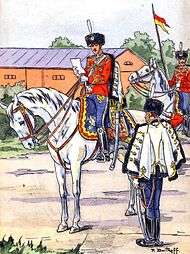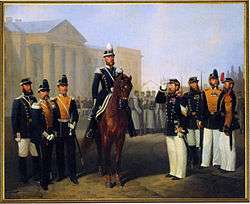Imperial Guard (Russia)
| Imperial Guard Лейб-гвардия | |
|---|---|
 Leib Guards reception at the Constantine Palace | |
| Active | 1683–1917 |
| Country |
|
| Allegiance |
Tsar of Russia and |
| Branch |
|
| Type | Infantry, cavalry and horse artillery |
| Role | Executive protection |
The Russian Imperial Guard, officially known as the Leib Guard (Russian: Лейб-гвардия leyb-gvardiya, from German Leib "Body"; cf. Life Guards / Bodyguard) were military units serving as personal guards of the Emperor of Russia. Peter the Great founded the first such units following the Prussian practice in the 1690s, to replace the politically motivated Streltsy. The Imperial Guard subsequently increased in size and diversity to become an elite corps of all branches within the Imperial Army rather than Household troops in direct attendance on the Tsar. Numerous links were however maintained with the Imperial family and the bulk of the regiments of the Imperial Guard were stationed in and around Saint Petersburg in peacetime.
History
The first units to be formed were the Preobrazhensky & the Semyonovsky Regiments by Peter the Great. He formed the two regiments as part of his move to professionalize Russia's army following their disastrous defeat in the Battle of Narva against the Swedish Empire during the early phases of Great Northern War. Another influencing factor for the unit's formation was the fact that the Streltsy had fallen out of favour with Peter as a result of a series of uprising, one taking place during his childhood which traumatised him, and another taking place during his reign.
Later on, Anna of Russia formed the Izmaylovsky Regiment recruited from her native Duchy of Courland and Semigallia out of distrust of her then current guard regiments (especially the Preobrazhensky) as a result of her paranoia of losing power. The Izmaylovsky Regiment became the official palace guards during Anna's reign.
But the term "leib" was not used until the reign of Elizabeth of Russia during her formation of the Leib Company made up of the grenadiers (especially the Preobrazhensky) who helped put her on the throne.[1]
During the October Revolution, the Pavlovsky Regiment, though celebrated for their actions during the Napoleonic Wars, was among the first regiments to mutiny and join the Bolsheviks, and participated in The Storming of the Winter Palace.[2] However, notable members like the then commander of the Preobrazhensky Regiment, Alexander Kutepov remained loyal to the end, fighting against the Bolsheviks.
Organization
The final composition of the Russian Imperial Guard at the beginning of 1914 was:

Guards Corps St. Petersburg District. Headquarters, St. Petersburg, Millionaya. (Guards units not part of the Guards Corps were the Guards Replacement Cavalry Regiment and Guards Field Gendarme Squadron.)
- 1st Guards Infantry Division. Headquarters, St. Petersburg, Fontanka
- 1st Brigade: Life-Guards Preobrazhensky Regiment, Life-Guards Semyonovsky Regiment
- 2nd Brigade: Life-Guards Izmailovsky Regiment, Life-Guards Egersky Regiment
- 1st Life-Guards Artillery Brigade
- 2nd Guards Infantry Division. Headquarters, St. Petersburg, Fontanka
- 1st Brigade: Life-Guards Moscow Regiment, Life-Guards Grenadier Regiment
- 2nd Brigade: Life-Guards Pavlovsky Regiment, Life-Guards Finliandsky Regiment
- 2nd Life-Guards Artillery Brigade
- 3rd Guards Infantry Division. Headquarters, Warsaw.
- 1st Brigade: Life-Guards Lithuanian Regiment, Emperor of Austria's Life-Guards Kexgolmsky Regiment
- 2nd Brigade: King Frederick-William III's Life-Guards St.-Petersburg/Petrograd Regiment, Life-Guards Volinsky Regiment
- 3rd Life-Guards Artillery Brigade
- 2nd Infantry Division
- Separate Guards Cavalry Brigade: His Majesty's Lancers, Grodno Hussars
- 3rd Battery of Life-Guards Horse Artillery
- 23rd Howitzer Artillery Battalion
- 9th Sapper Battalion
 Officers and soldiers of the Volhynian Life-Guards Regiment in Warsaw, 1864
Officers and soldiers of the Volhynian Life-Guards Regiment in Warsaw, 1864 - 1st Guards Cavalry Division. Headquarters, St. Petersburg, Fontanka
- 1st Brigade: Her Sovereign Majesty Empress Maria Theodorovna's Chevalier Guard Regiment, Life-Guards Horse Regiment
- 2nd Brigade: His Majesty's Life-Guards Cuirassier Regiment, Her Majesty Empress Maria Theodorovna's Life-Guards Cuirassier Regiment
- 3rd Brigade: His Majesty's Life-Guards Cossack Regiment, His Imperial Highness the Sovereign Heir and Tsesarevich's Life-Guards Ataman Regiment, Life-Guards Combined Cossack Regiment, 1st His Majesty's Ural Sotnia, 2nd Orenburg Sotnia, 3rd Combined Sotnia, 4th Amur Sotnia
- 1st Division of Life-Guards Horse-Artillery Brigade
- 2nd Guards Cavalry Division. Headquarters, St. Petersburg, Fontanka
- 1st Brigade: Life-Guards Horse-Grenadier Regiment, Her Majesty Empress Alexandra Theodorovna's Life-Guards Lancer Regiment
- 2nd Brigade: Life-Guards Dragoon Regiment, His Majesty's Life-Guards Hussar Regiment,
- 2nd Division of Life-Guards Horse-Artillery Brigade
- Guards Rifle Brigade. Headquarters, St. Petersburg, Fontanka
- Life-Guards 1st His Majesty's Rifle Regiment
- Life-Guards 2nd Tsarskoe-Selo Rifle Regiment
- Life-Guards 3rd His Majesty's Rifle Regiment
- Life-Guards 4th The Imperial Family's Rifle Regiment
- Guards Rifle Artillery Battalion
- Life-Guards Horse Artillery
- Guards Howitzer Artillery Battalion
- Life-Guards Sapper Battalion
- Guards Aviation Company
'Guard units of direct subordination as of 1917:
- Palace Grenadiers Company
- Guards Replacement Cavalry Regiment
- Guards Field Gendarme Squadron
- His Majesty's Guards Convoy Unit
- His Majesty's Railway Regiment
Plus the following were part of the 23rd Army Corps, Warsaw Military District. Headquarters, Warsaw, Poland.
- 3rd Guards Infantry Division. Headquarters, Warsaw
- Division HQ
- 1st Brigade: Life-Guards Lithuania Regiment, Emperor of Austria's Life-Guards Kexholm Regiment
- 2nd Brigade: King Frederick-William III's Life-Guards St.-Petersburg Regiment, Life-Guards Volynski Regiment
- 3rd Life-Guards Artillery Brigade
- Independent Guards Cavalry Brigade
- 3rd Battery of Life-Guards Horse Artillery
Ranks
Every soldier and officer of the Guard had the style of the Leib Guard (Лейб-гвардии...), for example: Colonel of the Leib Guard (Лейб-гвардии полковник). It is a misconception that the monarch himself functioned as the commander of the Leib Guard regiments, so only he and some members of the imperial family could hold a title of Colonel (Polkovnik) of the Guards. In fact, there were many guards officers in the rank of colonel.
Commissioned officers enjoyed a two-grade elevation in the Table of Ranks over regular army officers; this later changed to a one-grade elevation -- first for the New Guards then for the rest of the Leib Guard. Following the abolition of the rank of Major in 1884, most grades below VII shifted one position upwards, effectively returning to those of the Old Guards.
| Grade, Old Guards | Grade, New Guards | Category | Infantry | Cavalry, Cossacks until 1891 | Cossacks (since 1891) |
|---|---|---|---|---|---|
| IV | V | Staff Officers | Colonel (Полковник) | ||
| V | VI | Lieutenant colonel (Подполковник) (until 1798) | |||
| VI | VII | Premier Major, Second Major (Премьер-майор, секунд-майор) (until 1798) | |||
| VII | VIII | Ober-Officers | Captain (Капитан) | Rittmeister (Ротмистр) | Yesaul (Есаул) |
| VIII | IX | Staff Captain(Штабс-капитан) | Staff-Rittmeister (Штабс-ротмистр) | Junior Yesaul (Подъесаул) | |
| IX | X | Poruchik/Lieutenant (Поручик) | Sotnik (Сотник) | ||
| X | XI | Junior Poruchik/Sub-lieutenant (Подпоручик) | Khorunzhiy (Хорунжий) | ||
| XI | XII | Praporshchik (Прапорщик) | Cornet (Корнет) | ||
| XII | XIII | Under-Officers | Feldwebel (Фельдфебель) | ||
| XIII | XIV | Sergeant (Сержант) (1800-1884) | Wachtmeister (Вахмистр) | Junior Khorunzhiy (Подхорунжий) | |
| XIV | |||||
| Junior Praporshchik (Подпрапорщик); Senior Unteroffizier (Старший унтер-офицер) since 1800 | Wachtmeister (Вахмистр) | ||||
| Unteroffizier (Унтер-офицер) | Uryadnik (Урядник) | ||||
| Gefreiter (Ефрейтор) | Prikazny (Приказный) | ||||
| Privates | Musketeer, Fusilier, Grenadier etc. (Мушкетер, фузилер, гренадер и т.д.) | Dragoon, Hussar, Cuirassier, Cossack etc. (Драгун, гусар, кирасир, казак и т.д.) | Cossack (Казак) | ||